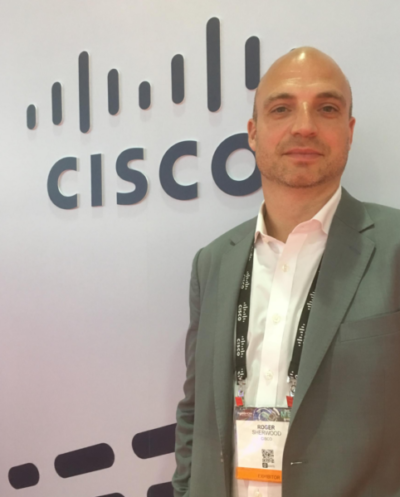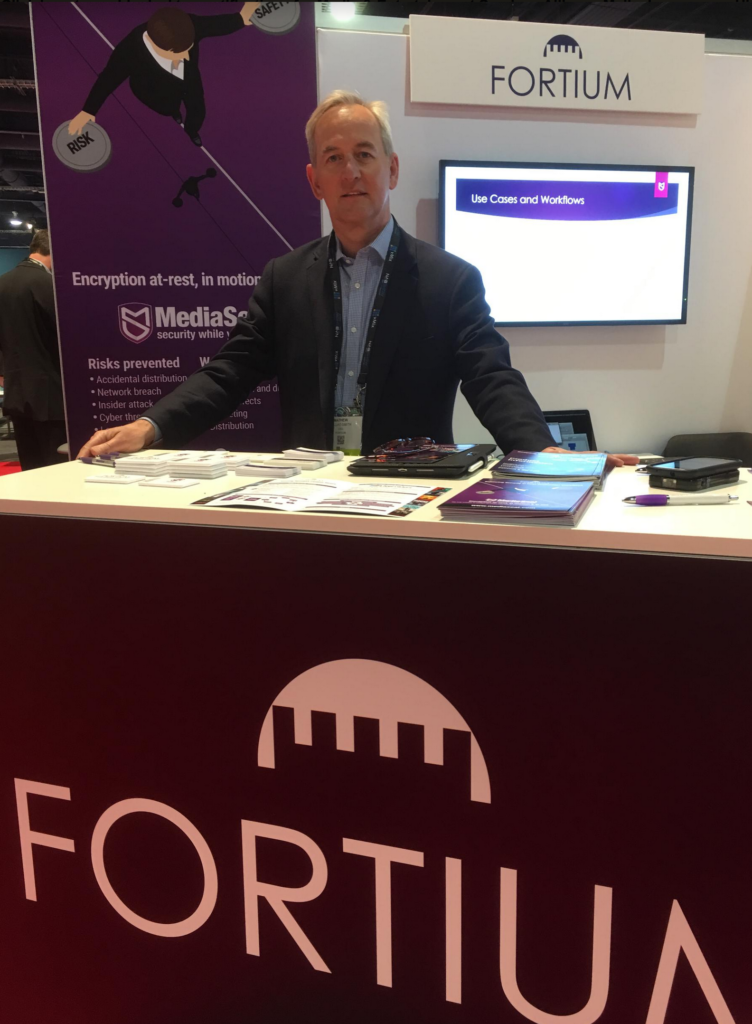LAS VEGAS — Members of the Media & Entertainment Services Alliance (MESA) brought a variety of new offerings to the annual NAB Show, covering security solutions, audio technology, content creation and distribution, and more.
Here’s a look at what Cisco, Deluxe, Dolby, and Fortium had to share.
Cisco
At the NAB Show, Cisco is again touting its IP networking and security solutions, as well as its overall Media Blueprint set of infrastructure and software solutions that it first unveiled at the show in 2016.
Cisco added new solutions to its Media Blueprint and its focus continues to be on “industrializing the ecosystem in media,” Roger Sherwood, Cisco global industry director for media & entertainment, told the Media & Entertainment Services Alliance (MESA) April 9.
“We’ve got a record number of meetings set up” at NAB and “we’ve got global customers coming,” he said, adding the company has placed a “heavy focus on video the last couple of years” and that continues at the show. The goal has been to “penetrate traditional broadcast operations,” he said, and, “this year, it’s been very much about” the question “how do we extend our portfolio to IT?”
A “quote that you’ll see quite a lot of is ‘there’s a lot more IT in broadcast, a lot more broadcast in IT’” – and that “plays very much into our sweet spot of the legacy protocols are going away [and] a lot of these tools and systems are starting to look like traditional IT now,” he said, adding: “We’re really starting to see that convergence happening on the customer side too.”
 Cisco is also continuing to focus on its message that “security is the foundation of everything” and “without security built in to all of these products and solutions, you shouldn’t be building a business,” he said, noting the company is demonstrating security at its NAB booth.
Cisco is also continuing to focus on its message that “security is the foundation of everything” and “without security built in to all of these products and solutions, you shouldn’t be building a business,” he said, noting the company is demonstrating security at its NAB booth.
Sherwood’s “hoping that media companies will start” focusing a lot more on the need for security, he said, adding he was “surprised that there are still – considering the value of content that these guys produce, considering that it’s their crown jewels – a lot of customers that we talk to” still not developing a “holistic” software strategy “for the entire company.” But he predicted “that’s going to change” as more companies find their content held for “ransom.”
Cisco’s customers “are starting to understand” the importance of security, but “from an organizational perspective, it has to come from the senior executives at these companies,” who must start thinking differently about their approach to security, he said.
There’s a lot of talk and demonstrations of 8K at NAB this year.
But Sherwood said: “There’s the reality of where is it actually being deployed? Yeah, some of the high-end device manufacturers will be saying that’s where it’ll go.”
He predicted the 2020 Summer Olympics in Tokyo “will drive a lot of that; there will be a lot of noise around that.” But “the reality is consumers are only really starting to buy 4K” TVs today,” he said. From Cisco’s perspective, “a lot of what we talk about is future-proofing” upgrades, he told MESA, noting that “once you move to an IP infrastructure – a virtualized infrastructure – those upgrades become a lot more seamless” than what we saw “in the past,” when upgrading from SD to HD, as an example.
Deluxe
Deluxe Entertainment Services Group is collaborating with technology companies DLVR Inc. and Hybrik on the new Deluxe One open platform that was announced at the NAB Show.
DLVR’s video delivery optimization data and services, which help video publishers achieve peak streaming performance on each device, have been integrated into Deluxe One, the companies said April 10. “By capturing atomic-level video delivery data, DLVR is able to proactively route video traffic to the most performant” content delivery network (CDN), “avoiding hazards such as network slowdowns or outages, and improving overall streaming stability and quality,” DLVR said. It’s entirely cloud-based optimizations don’t require any software development kits or plug-ins, “eliminating the resources needed for development and testing client-side updates and future-proofing the service for new devices entering the market,” it said.
Deluxe, meanwhile, selected Hybrik as its cloud transcoding provider for Deluxe One. By using Hybrik’s cloud-based media processing, Deluxe can “rapidly respond to customer growth and emerging format requirements,” the companies said in a news release. Selecting Hybrik to be a “key partner” for the Deluxe One ecosystem “ensures that we will always have the capacity and quality we need to support growing demand in both volume and advanced formats” including 4K resolution and High Dynamic Range (HDR), Andy Shenkler, Deluxe chief product officer, said.
The Deluxe One open platform was designed to “unify global content creation and distribution,” Deluxe said at the NAB Show April 9.
Deluxe One “unifies every stage of the content ecosystem — from creation to viewer experience — in one cloud-based interface,” Deluxe said in its announcement. The platform was designed to “integrate with any vendor or customer system, allowing users to succeed in an age where the lines between creator and distributor are becoming increasingly blurred,” the company said.
Dolby
Dolby continues to gain momentum on not only the Dolby AC-4 next-generation audio format, but its Dolby Atmos immersive sound technology and Dolby Vision High Dynamic Range (HDR) format as well, the company is stressing here at the NAB Show.
“We see really great momentum at Dolby with the adoption of Dolby Atmos and Dolby Vision by the top worldwide service and content providers and distributors,” Mathias Bendull, Dolby VP-Multi-Screen Services Audio, told the Media & Entertainment Services Alliance (MESA).
He pointed to Netflix as one prominent example of a company distributing content using Dolby Atmos and Dolby Vision. “We just see that the industry is coming around and perceiving Dolby Vision and Dolby Atmos as mass market, deployable technology,” he said.
Meanwhile, “working with content creators to create content in Dolby Vision is something that we’ve been doing for a number of years,” Stephen Auld, Dolby senior manager for business strategy-imaging playback, told MESA. “In fact, Dolby’s really been at the heart of creating this momentum” that we’re seeing for HDR in the industry, he said.
On the content side, in addition to strong Netflix support, there are now “over 200 titles in Dolby Vision” on Apple’s iTunes store and Amazon also supports the format, Auld said.
There are, meanwhile, now 12 TV makers supporting Dolby Vision playback and it’s often at “mainstream prices – so below $500 now, you get a great television with Dolby Vision playback capabilities,” Auld said.
Dolby is now working with its partners to “look at how we can deliver Dolby Vision experiences in a live environment,” Auld also told MESA. “We’ve done some great trials over the past year,” including with France Televisions on the French Open tennis finals (also using Atmos and AC-4) in 2017, he noted.
On the Atmos front, Bendull pointed to the recent announcements regarding Huawei and Samsung mobile device support. Dolby announced a partnership with Huawei March 27 to launch the new P20 and P20 Pro smartphones with Atmos sound and AC-4. Earlier this year, Dolby announced a partnership with Samsung to launch the new Galaxy S9 and Galaxy S9+ smartphones with Atmos.
Five of the top six Chinese TV makers, meanwhile, are now supporting Atmos in their TVs (after already supporting Dolby Vision), Bendull said. TCL became the first TV OEM to announce an Atmos and Dolby Vision TV in China. Joining TCL were Changhong, Hisense, Konka and Skyworth, Dolby said.
But, at the NAB Show, the big news from Dolby came on the ATSC 3.0 broadcast TV front as part of its partnership with the Pearl TV organization of U.S. broadcasters that include Cox Media Group, the E.W. Scripps Company, Hearst Television and others.
Pearl TV announced that Dolby, along with several other key partners, are working together to get the first next-generation TV signal test bed in the Phoenix Model Market on-air using ATSC 3.0. Dolby is providing encoding and decoding technology to add key audio features with AC-4 and is working closely with video delivery service provider Harmonic on the implementation of the ATSC 3.0 next-generation audio format in their broadcast and over-the-top workflows, Pearl TV said.
Fortium
Fortium’s focus at the NAB Show is again communicating how media and entertainment companies can keep content secure through its range of both disc- and file-based security solutions.
The company is touting new features of its MediaSeal file encryption software for easier-to-use file security for TV and film post production in sound and picture editing, localization and marketing, according to its CEO, Mathew Gilliat-Smith. One major new feature of MediaSeal is LiveFolders, which enhances security by making encryption automatic and transparent, according to Fortium.
 Files are encrypted instantly when saved to a LiveFolder and decrypted automatically when accessed by an authenticated user, it said, noting files are encrypted whenever they are created, saved or transferred.
Files are encrypted instantly when saved to a LiveFolder and decrypted automatically when accessed by an authenticated user, it said, noting files are encrypted whenever they are created, saved or transferred.
Sensitive content is kept safe from hackers and accidental sharing with unauthorized parties, it said.
The company continues to see strong demand for MediaSeal, Gilliat-Smith told the Media & Entertainment Services Alliance (MESA) April 9. That’s only increased – “especially some very big customers” — since introducing a new, “pay-as-you-go, eat-as-much-as-you-want” pricing model, which he said “seems to work very well” for customers.
That was implemented last year, he said, noting Fortium started with an enterprise license model, where customers paid for the software and owned it. The cost had been one of three “pushback” points for potential customers prior to the pricing model change, he said, noting the other two obstacles the company faced were MediaSeal representing a “step change” in organizations’ workflows and the fact that prospective customers hadn’t been hacked yet.
It was a “real eye opener” for him, while attending the Cyber Security & Content Protection Summit at the NAB Show April 8, to hear about some of the “increasing threats” to content that the media and entertainment industry faces, he also said. At the same time, many people continue to underestimate the ability of hackers to access their content, he said.
